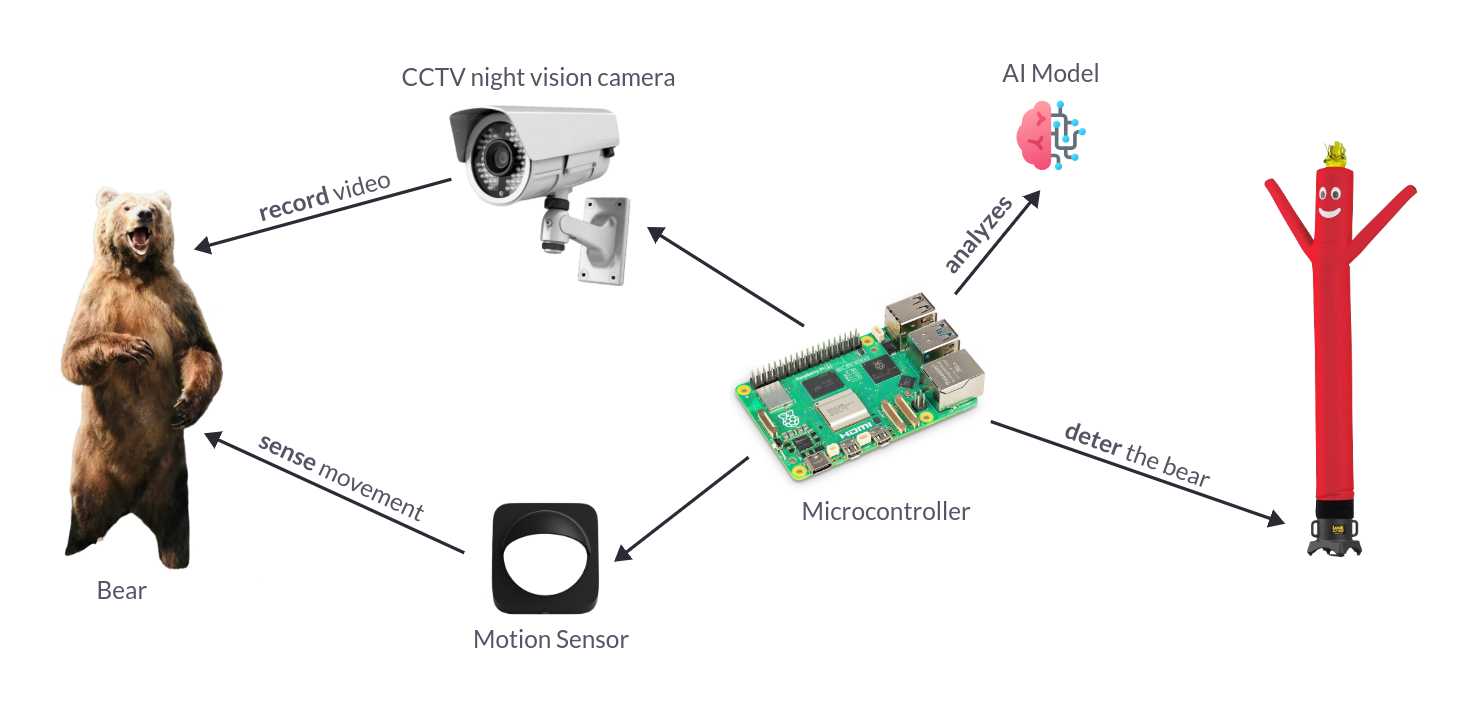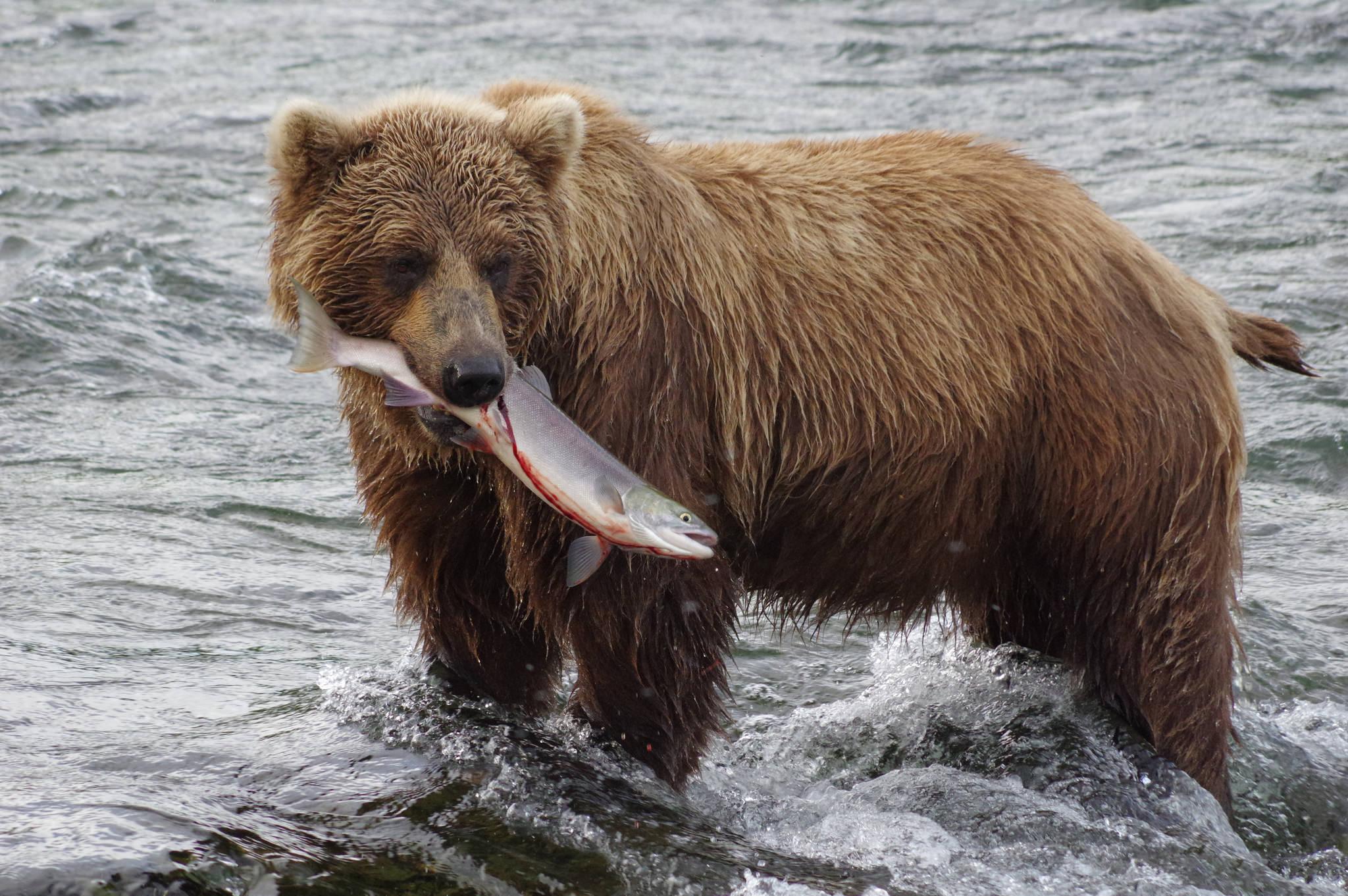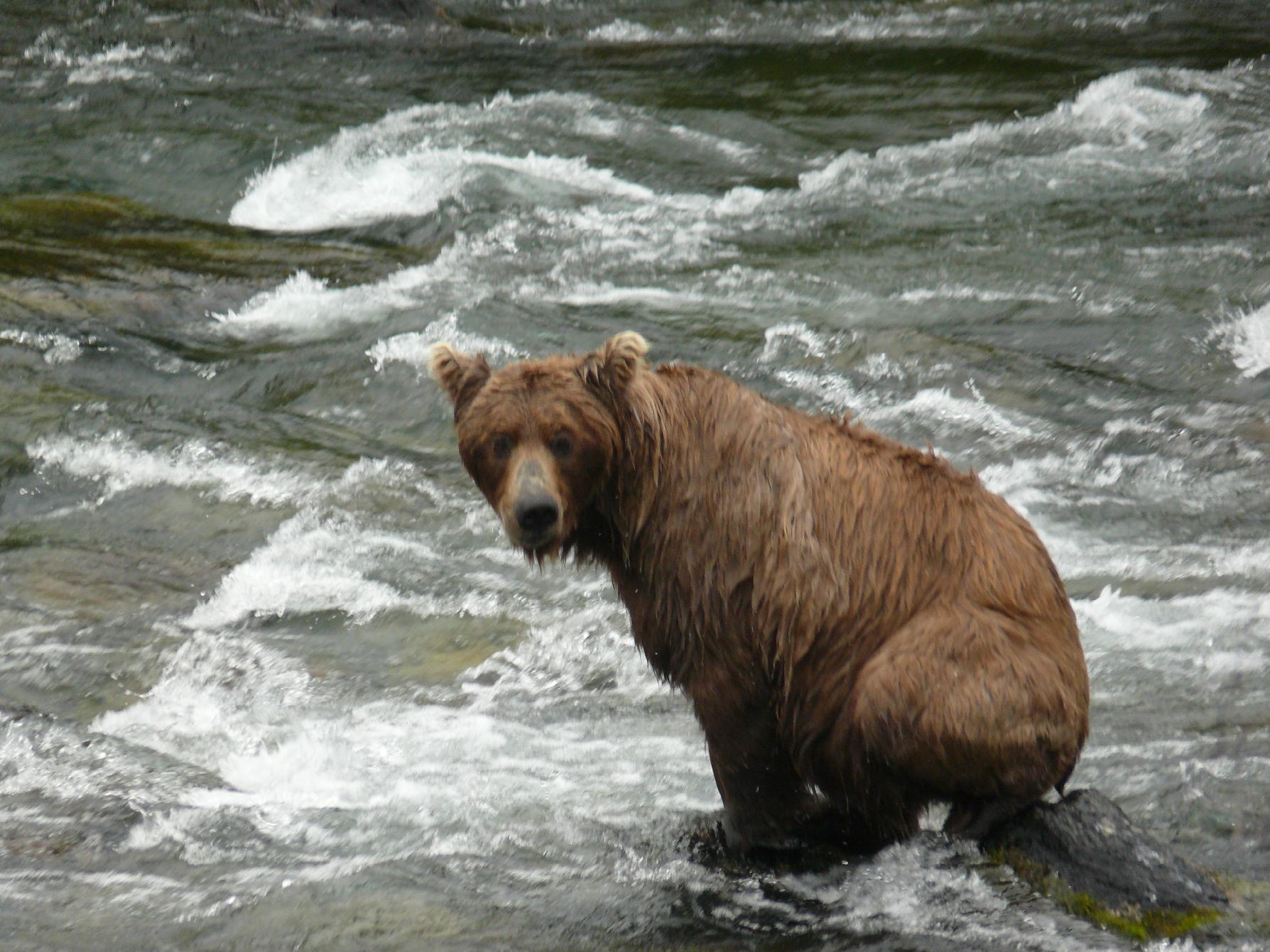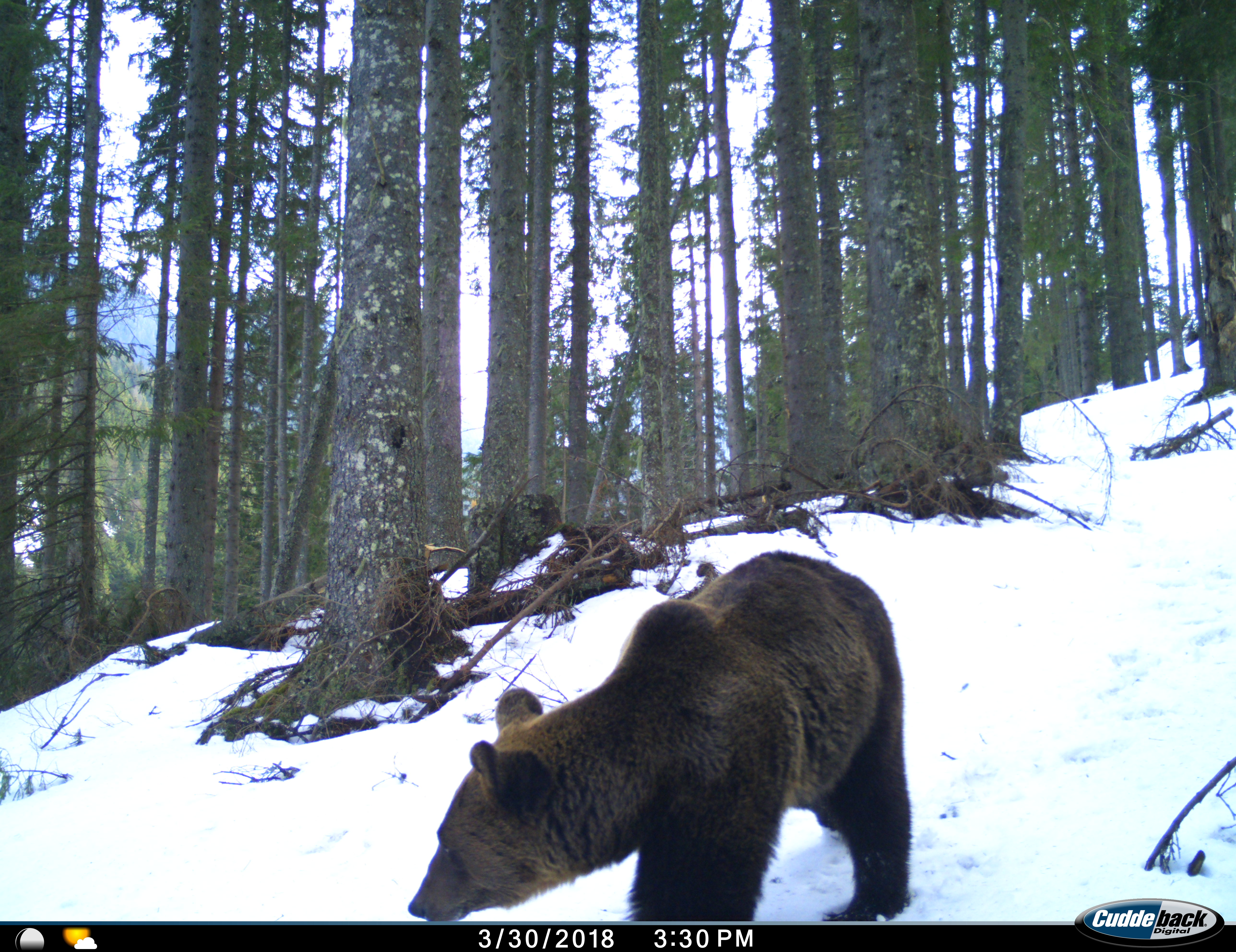Appeasing human-bear conflict
Human-Wildlife Conflict

Brown bears serve as pivotal indicators and umbrella species, playing a crucial role in ecological balance. Managing Human-Wildlife Conflict in regions inhabited by these apex predators is paramount for safeguarding the overall health of ecosystems.
Implementing non-invasive methods to deter bears from approaching farms and livestock holds promise in fostering harmonious relations between humans and bears.
 Bear Scare System Overview
Bear Scare System Overview
Our ongoing research and development of a software tool aim to offer a cost-effective, scalable, and versatile solution applicable not only to bears but also to other species. This initiative has the potential to significantly contribute to resolving human-wildlife conflicts on a global scale.
Bears are vital for healthy ecosystems
Bears play a crucial role in maintaining healthy ecosystems due to their position as apex predators and their significant influence on various ecological processes. Here are several reasons why bears are vital for ecosystem health:
- Regulation of Prey Populations: As apex predators, bears help control populations of prey species such as deer, elk, and fish. By regulating these populations, bears prevent overgrazing and maintain the balance of plant communities, which in turn affects other species dependent on those plants.
- Seed Dispersal: Bears are omnivores and consume a diverse diet, including fruits, berries, and nuts. As they travel through their habitats, bears inadvertently scatter seeds through their feces, helping to disperse plant species and promote biodiversity.
- Nutrient Cycling: When bears catch prey or forage for food, they often leave behind carcasses or plant remains. These organic materials provide nutrients to the soil and support the growth of vegetation. Additionally, bear feces contribute to nutrient cycling by enriching the soil with nitrogen, phosphorus, and other essential elements.
- Ecosystem Engineering: Bears are known to engage in behaviors that shape their environment, such as excavating dens or overturning logs in search of food. These activities can have cascading effects on ecosystem dynamics by creating habitats for other species or influencing nutrient cycling.
- Indicator Species: Bears serve as indicators of ecosystem health. Their presence, abundance, and behavior can provide insights into the overall condition of the ecosystem, including factors such as habitat quality, food availability, and human impacts.
Overall, the presence of bears in an ecosystem signifies a healthy and balanced environment. Protecting and conserving bear populations is not only essential for their survival but also for the integrity and resilience of the ecosystems they inhabit.




Conservation concerns
Conservation concerns for brown bears stem from various factors that threaten their populations and habitats. Some of the key reasons include:
- Habitat Loss and Fragmentation: Human activities such as deforestation, urbanization, agriculture, and infrastructure development have led to the loss and fragmentation of brown bear habitats. As their habitats shrink and become fragmented, brown bears face challenges in finding suitable areas for foraging, denning, and breeding.
- Human-Wildlife Conflict: Encounters between brown bears and humans often result in conflicts, particularly in regions where humans have encroached upon bear habitats. Conflicts arise due to predation on livestock, crop damage, and perceived threats to human safety. In response, bears may be persecuted through hunting or lethal control measures, further exacerbating conservation concerns.
- Illegal Poaching and Trade: Brown bears are targeted by poachers for their body parts, including fur, claws, and organs, which are used in traditional medicine, cultural practices, or as trophies. Illegal poaching and trade contribute to population declines and disrupt ecosystem dynamics.
- Climate Change: Climate change is altering brown bear habitats by affecting food availability, altering vegetation patterns, and impacting hibernation behaviors. Changes in climate can lead to mismatches in the timing of key events, such as denning and berry ripening, which can negatively impact brown bear populations.
- Habitat Degradation: Human activities such as mining, logging, and recreational activities can degrade brown bear habitats through habitat destruction, pollution, and disturbance. Degraded habitats may not be able to support healthy brown bear populations or provide essential resources for their survival.
- Inadequate Legal Protections: In some regions, brown bears may lack adequate legal protections or face weak enforcement of existing conservation laws. This can result in unchecked exploitation, habitat destruction, and other threats to brown bear populations.
Addressing these conservation concerns requires concerted efforts involving habitat protection, mitigating human-wildlife conflicts, combating illegal poaching and trade, implementing climate adaptation strategies, and promoting policies that ensure the long-term survival of brown bears and their habitats.
Project Scope and Objectives
Our collaboration aims to lead the development of innovative, non-invasive solutions for detecting bears in real-time environments. The primary focus of our efforts lies in pioneering software tools for bear detection, while our partner, HackThePlanet, specializes in the electronic packaging aspect.
Our system integrates a motion sensor and a CCTV night vision camera, both of which are controlled by a microcontroller. The microcontroller hosts a bear detection model, which promptly triggers a bear deterrent mechanism upon detection, effectively deterring the bear and ensuring safety.
The detection system’s priority is to optimize recall, ensuring it accurately localizes bears with high precision when they approach. Simultaneously, it aims to minimize false positives, particularly those that may arise from routine activities such as livestock feeding around the farms.
 Bear Scare System Overview
Bear Scare System Overview
Addressing Challenges in Brown Bear Detection
Brown bears present an ideal opportunity to advance bear detection technology for use on low-power devices:
- Activity Patterns: Brown bears are primarily crepuscular, exhibiting peak activity during dawn and dusk. However, their behavior may vary based on factors such as food availability, season, and human presence. In regions with significant human activity, brown bears might adjust their behavior to minimize encounters, potentially increasing activity during nighttime. While opportunistic feeders, their activity can occur at any time of day or night, depending on food availability.




- System Requirements: The detection system must prioritize low power consumption, require minimal maintenance, and operate effectively in remote environments.
- Deterrent Safety: Any deterrent system employed should ensure the safety of both animals and humans, posing no harm to either.
- False Positive Mitigation: It is essential for the detection model to maintain a low false positive rate, fostering trust within the farming community that will utilize the system.
Deterrent
The chosen deterrent system consists of an inflatable tube man, capable of rapid inflation upon bear detection in a video frame. This solution offers affordability, low power consumption, and harmlessness, with easy replaceability. However, it remains uncertain whether bears can learn to disregard the deterrent over time, necessitating iterative improvements to the system as required in the future.


Conclusion
The state-of-the-art Machine Learning model developed for real-time, low-power bear detection marks a significant milestone in mitigating human-wildlife conflicts. By fostering the creation of open-source tools, this project makes a substantial contribution toward harmonizing the coexistence of farmers and predators like bears. Moreover, its potential extends beyond bear management, offering promising avenues for resolving human-wildlife conflicts across diverse species.
Instant Bear Scare Device Demo by HackThePlanetOne can try out the model from the ML Space or directly from the snippet below:

Coral Reefs Health Monitoring

